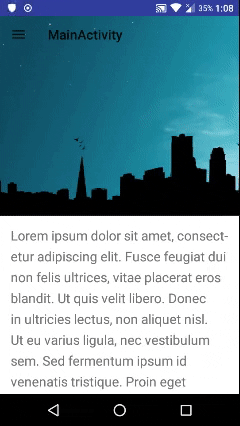Collapsing Toolbar only for one Fragment in Navigation View
It seems you want to achieve something like this.
I have made an activity with common toolbar. when switching to the collapsing toolbar fragment I've made the toolbar transparent and fragment's toolbar takes over. The toolbar's color remains the same on switching to other fragments.
This allows you to manage complete collapsing toolbar's layout structure in xml and logic remains in Fragment.
Hope this will help. Refer the gif linked.
The best solution that I found to easily collapse, lock it(keep it in collapsed mode) and unlock the collapsingToolbar.
private void collapseAppBar() { // Collapse the AppBarLayout with animation mAppBarLayout.setExpanded(false, true);}private void lockAppBar() { /* Disable the nestedScrolling to disable expanding the appBar with dragging the nestedScrollView below it */ ViewCompat.setNestedScrollingEnabled(nestedScrollView, false); /* But still appBar is expandable with dragging the appBar itself and below code disables that too */ CoordinatorLayout.LayoutParams params = (CoordinatorLayout.LayoutParams) mAppBarLayout.getLayoutParams(); AppBarLayout.Behavior behavior = (AppBarLayout.Behavior) params.getBehavior(); behavior.setDragCallback(new AppBarLayout.Behavior.DragCallback() { @Override public boolean canDrag(AppBarLayout appBarLayout) { return false; } });}private void unLockAppBar() { ViewCompat.setNestedScrollingEnabled(nestedScrollView, true); CoordinatorLayout.LayoutParams params = (CoordinatorLayout.LayoutParams) mAppBarLayout.getLayoutParams(); AppBarLayout.Behavior behavior = (AppBarLayout.Behavior) params.getBehavior(); if (behavior != null) { behavior.setDragCallback(new AppBarLayout.Behavior.DragCallback() { @Override public boolean canDrag(AppBarLayout appBarLayout) { return true; } }); }}And I use these functions in this way:
Fragment fragment = null; Class fragmentClass; switch (menuItem.getItemId()) { case R.id.fragment1: unLockAppBar(); fragmentClass = first_Fragment.class; break; case R.id.fragment2: collapseAppBar(); lockAppBar(); fragmentClass = second_Fragment.class; break; case R.id.fragment3: collapseAppBar(); lockAppBar(); fragmentClass = third_Fragment.class; break;
You can easily get the Toolbar from your Fragment and then modify or change some property of that Toolbar inside the Fragment.
To get the Toolbar from your Activity you might consider using this.
Toolbar toolbar = (Toolbar) getActivity().findViewById(R.id.toolbar);Now you need to make the changes on the Toolbar in the onResume function and then undo the changes each time you return from the Fragment inside onStop function. Otherwise the changes made in the Fragment will be carried on to other fragments as well when switched to other Fragment from the navigation drawer.
But in your case, I would recommend each Fragment should have their Toolbar so that it doesn't conflict with each other and can be modified as you need. And yes, remove the Toolbar from your Activity.
So add the Toolbar in the layout of your Fragment like this.
<android.support.v7.widget.Toolbar xmlns:android="http://schemas.android.com/apk/res/android" android:id="@+id/toolbar" android:layout_width="match_parent" android:layout_height="wrap_content" android:background="?attr/colorPrimaryDark"/>Then find it in the Fragment
@Overridepublic View onCreateView(LayoutInflater inflater, ViewGroup container, Bundle savedInstanceState) { View view = inflater.inflate(R.layout.fragment, container, false); Toolbar toolbar = (Toolbar) view.findViewById(R.id.toolbar); // Modify your Toolbar here. // ... // For example. // toolbar.setBackground(R.color.red); // Create home button AppCompatActivity activity = (AppCompatActivity) getActivity(); activity.setSupportActionBar(toolbar); activity.getSupportActionBar().setDisplayHomeAsUpEnabled(true);}And Override the onOptionsItemSelected function.
@Overridepublic boolean onOptionsItemSelected(MenuItem item) { switch(item.getItemId()){ case android.R.id.home: getActivity().onBackPressed(); } return super.onOptionsItemSelected(item);}